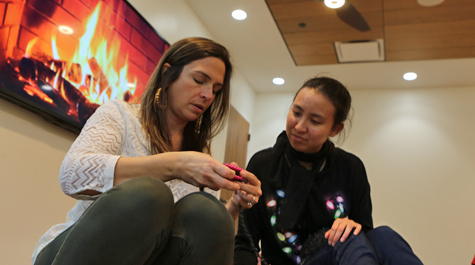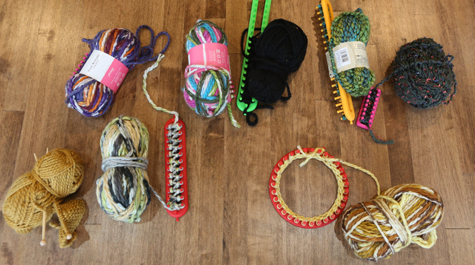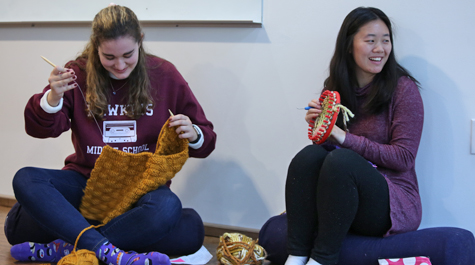Art therapy at W&M offers ‘practice for outside’
Students sit in a semicircle, their fingers guiding brightly colored yarn around small looms or along fluttering needles. In front of them, a wall of windows showcases snow falling gently against the blazingly bright colors of fall.
Sarah Balascio moves among the students, inquiring about their progress and offering advice. But she really isn’t concerned much about the quality of the scarves, hats or other knitted goods they create.
“Being a William & Mary student is so challenging and there’s so much pressure about doing things right, so I like students having the chance to be messy, to make mistakes, to try something they feel is risky,” Balascio said.
The knitting group, new this semester, is one of several art therapy offerings available at W&M’s McLeod Tyler Wellness Center. Balascio, an art therapist and adjunct lecturer, has been leading sessions at W&M since she began working at the university’s counseling center four years ago. But since the wellness center opened last fall, she has been able to offer a wider range of art therapy to more people.
{{youtube:medium|Lxk-_x_IpBI, Knitting wellness}}
“Art therapy is important because it can help us express ourselves and understand ourselves in ways that talking just can't,” Balascio said. “It can help increase positive mood, decrease stress, build sense of self and experience mindfulness.”
People can also benefit from just looking at art, listening to music or watching performances, Balascio said.
“I feel like art should be a part of our daily routines just like you would think of walking or yoga or exercise and eating well.”
A revelation
An art major in college, Balascio worked as a teacher before she had a realization.
“I realized that what I liked best about being an art teacher wasn’t about teaching a skill,” she said. “It wasn’t so much that I could show you how to knit, it was what you’re getting out of it.”
Balascio returned to school and earned a master’s degree in art therapy. She worked as an art therapist in a number of psychiatric hospitals before being hired by W&M. It’s the best job she’s ever had, Balascio said.
“I just love seeing the students take care of themselves,” she said.
Despite misconceptions, art therapy is for everyone, including those who think they don’t have any artistic talent, said Balascio.
“They say they can’t draw a stick figure,” she said. “Those are my favorite people because I feel like anyone can be an artist — just like anything, the more you do it, the better you get at it.”
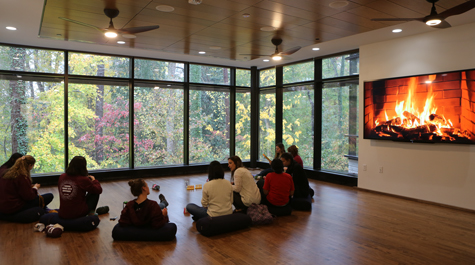 However, much of art therapy isn’t about a final product, she said. It’s more about the process, and sometimes, the art isn’t even kept. To those concerned about their art being “bad,” Balascio asks, “What’s the harm?”
However, much of art therapy isn’t about a final product, she said. It’s more about the process, and sometimes, the art isn’t even kept. To those concerned about their art being “bad,” Balascio asks, “What’s the harm?”
“If we try it and it turns out ‘ugly,’ we throw it out,” she said. “That might be an avenue we explore with a person — what if you do make something you don’t feel good about, what does that mean? That can be typical here with students who are used to doing everything perfectly. What does it feel like to really mess up and make something that I don’t find attractive?
“I like to look at art therapy and art work as practice for outside. You need to try and have a failed art piece because sometimes in life, you’re going to fail.”
Art and creation are crucial pieces of the human experience, said Lindsay Heck, integrative wellness manager.
“From the buildings we occupy every day to the music we listen to and the ideas we read, artists have a unique way of pulling out what's within,” she said. “Sarah facilitates this in her class. She helps people find quiet moments and flow that allow you to connect with yourself. She gives us a safe space to share ideas, feelings and thoughts that may be difficult to express in words and then provides the tools to translate them into art.
“With Sarah you may capture a moment with an old friend on film or connect with a new one while creating mittens. At its root, Sarah's classes are an important facet of our wellness programming because she gives people a platform to express themselves that is free of expectation.”
Me time
Currently, Balascio facilitates a creative arts group and a mindful arts group for students, and she hosts a women’s creativity group for faculty and staff. She is also teaching one-credit wellness application courses each semester. In the fall, that course focuses on visual arts, and in the spring, it focuses on the health benefits of all other art forms including dance, music, writing and drama.
In addition, Balascio co-facilitates a group for trauma survivors at The Haven, a confidential resource center for people affected by sexual violence, relationship abuse and gender-based discrimination, and she responds to special requests for small-group sessions. For instance, she hosted a team-building activity for the information technology department at the beginning of the academic year, and she recently led a session for transgender students through the Rainbow Coalition.
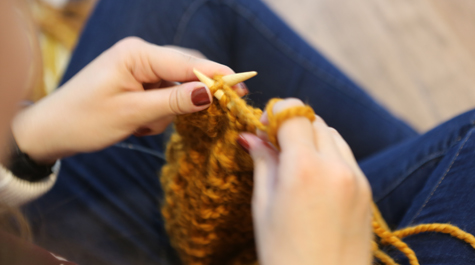 In the knitting group, Balascio asks the students at the beginning to think about how they are feeling, physically and emotionally. At the end, she asks each again.
In the knitting group, Balascio asks the students at the beginning to think about how they are feeling, physically and emotionally. At the end, she asks each again.
Jillannie Coimbre ’22 was feeling ill at the first meeting of the knitting group and experienced a splitting headache.
“Working on the knitting, the headache just faded to the background so I wasn’t really aware of it throughout,” said Coimbre. “And at the end, I shook my head just to test it, and it was still there but dulled.”
Coimbre, who enjoys handicrafts and currently makes dreamcatchers, joined the class to learn a new skill, but she has found even more through the experience.
“They say that knitting puts you in a state similar to meditating, and that’s the case with me,” she said.
Natalie Larsen ’21, an experienced knitter, is also gaining more than just progress on her current project with the group.
“I thought it would be a great way to put aside an hour of my week every week and kind of use that as relaxation time to spend time not worrying about schoolwork or anything else, and just kind of sit and have time to myself,” she said.
Jenna Holliman ’21, who recently started crocheting, echoed Larsen’s sentiment.
“It’s just really nice to have this down time because the weeks are so busy with classwork and extracurriculars,” she said.
Balascio loves to see students setting aside time for themselves, especially during busy parts of the year.
“I love when they say, ‘I almost didn’t come but came anyway,’ because I think that’s when it’s needed the most — those stressful times of the semester,” she said.
Many faculty and staff experience the same thing, thinking they can’t afford to take a break from their work, said Balascio.
“But then there’s this feeling of, wow, I’m actually going to be more centered and productive now,” she said. “I love hearing that.”
To find out more about art therapy or to register, visit the Campus Recreation Portal or email Balascio at sjbalascio@wm.edu. Skip to main content
Skip to main content

